Special Feature: Products Sally Recommends
the chocolatiers' roundtable
Recently, I virtually sat down with four different chocolatiers, to get their views on everything from trends in the chocolate world to what they do better than anyone else. It would be difficult to find four people more diverse or more different in their approach to their profession, but they all bring something special to the world of fine chocolates. The chocolatiers are Jeff Shepherd of Lillie Belle Farms (www.lilliebellefarms.com); Antoine Amrani, of Antoine Amrani Chocolates (www.antoineamrani.com); Fritz Knipschildt, of Knipschildt Chocolatier (www.knipschildt.com); and Martine Leventer, of Martine’s Chocolates (www.martineschocolates.com). If you haven’t already done so, I hope you’ll make a point to try the products of all of these chocolatiers, so you can appreciate their delicious, if sometimes polar, perspectives. Because some answers to my questions were very lengthy, I’ve had to abridge them. Chocolatiers are listed in the order in which they replied to my questions
1) What formal education, if any, do you have in pastry/chocolates?
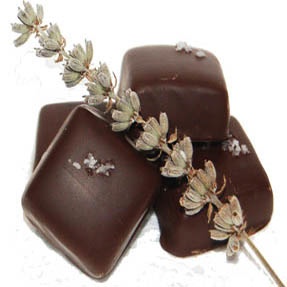 Jeff: None
Jeff: None
Antoine: I was trained in Paris at the Ritz Escoffier and later…alongside some of the top European masters in chocolate. I interned at the famous Demoncy Pastry Shop in Paris…when I came to the US, I worked closely with an ambassador for (chocolate maker) Barry Callebaut at Le Bec Fin
Fritz: I went to hotel and restaurant school for four and a half years in Denmark
Martine: Nothing in pastry. Training courses in artisan chocolate-making in Europe and the US, and, of course, practice in my own shop…there are some professions where practicing is, in my opinion, the best education…chocolate-making (is one of) these professions
2) For those considering going into the chocolate business, how long was it from the day you opened until you saw your first dollar in profit?
Jeff: Five years
Antoine: (Note: Antoine Amrani chocolates opened in July of 2009; all other chocolatiers here have been in business since 2001 or before that year. This business is not yet profitable.)
Fritz: No such thing, keep reinvesting in the business
Martine: I opened the business in November 1992 and started to pay myself at the beginning of 1996
3) How did you begin selling your chocolates?
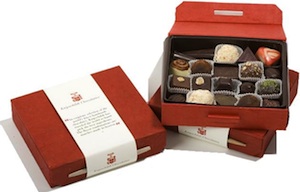 Jeff: A farmers’ market
Jeff: A farmers’ market
Antoine: At Le Bec Fin, as Executive Pastry Chef…chocolates were served to all the guests. The chocolates I created were also sold by Le Bec Fin to casinos, hotels, and private clients
Fritz: I came up with a product and went and knocked on doors of restaurants and gourmet shops
Martine: Where they were (and still are) made, the sixth floor of Bloomingdale’s (in New York City)
4) How do you describe your chocolates? Are they of any particular style?
Jeff: They are elegant yet simple
Antoine: I…combine two styles of chocolates, the classic French palet and the molded, shaped bon bon, which is more of a Swiss or Belgian style. I love the simplicity of the flatter, smoother palet and the contrast of my domed, decorated bon bons. I use classic European style recipes combined with unexpected flavor combinations
Fritz: They are handmade, artisan chocolates. They’re made fresh everyday…and most of the chocolates are infused with fresh herbs and spices
Martine: Very fine, fresh chocolates, handmade daily without chemicals or preservatives. Mainly molded…using European molds. The variety does not come from “flavoring” a ganache, but using different recipes and textures, and…offering a choice of dark or milk chocolate, sometimes even white, with the same recipe
5) What’s your best-selling piece?
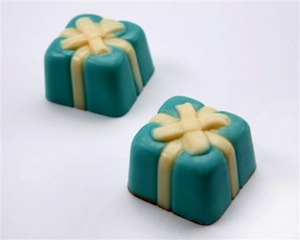 Jeff: Lavender fleur de sel caramels
Jeff: Lavender fleur de sel caramels
Antoine: All my chocolates are sold in assortments…There are some pieces I hear are favorites, (including) the Pure Dark, Organic Coconut Kaffir Lime, Cinnamon Honey, (and) Pistachio
Fritz: The Hannah, burnt caramel molded in a 71% Ecuadorian single bean dark chocolate topped with pink Hawaiian sea salt
Martine: The Oyster (a blend of five different Belgian chocolates)
6) Which piece has been your biggest surprise---that is, a piece you thought would be really popular but wasn’t, or, conversely, one that you were unsure about introducing but turned out to be a favorite with customers?
Jeff: The biggest surprise has been the smoky blue cheese truffle. I really didn’t think it would work, but once people taste it they always come back for more
Antoine: Coffee Sour Cherry…(it’s) very dramatic…a deep red color. The flavor combination is very surprising too, because when Americans hear “cherry and chocolate”, they think of something entirely different from this bon bon. I hand-pit a cherry, soak it in Grand Marnier, then surround it in a duo café chocolate ganache and enrobe it in 70% dark
Fritz: No big surprises. I have a savory background, so I knew which flavors to put together to please…customers’ palates, and which ones would not mix well
Martine: Considering the wide choice we have with hazelnut praline, I’m always amazed at how many King Tuts we are selling (the King Tut is a milk or dark chocolate piece filled with gianduja---a mixture of hazelnut paste and chocolate)
7) 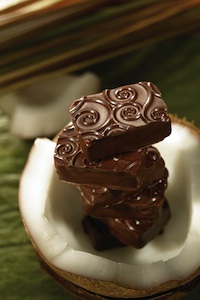 What are your favorite flavors to combine with chocolate?
What are your favorite flavors to combine with chocolate?
Jeff: Coconut, cheese, chile, and coquelicot (this is a poppy flower confit)
Antoine: I like working with different pralines (nut pastes) which I enjoy making and always create from scratch. I experiment with different spices or even fresh citrus to flavor (the) pralines
Fritz: I love to combine herbs and spices, such as nutmeg, ginger, basil, and rosewater, with chocolate
Martine: Raspberry and banana (as pureed fruit, not a flavor)…but there are many more, (such as) orange, apricot, bitter cherry, cranberry…come to think of it, all of them are fruit, (most with) a tart lingering taste. And with dark chocolate
8) What do you do better than any other chocolatier?
Jeff: Self promote
Antoine: It is not my point of view to say I’m better than another chocolatier, as there are so many unique talents and styles. I have worked on my craft for many years to create well-balanced flavor combinations in my ganaches…because I do not use fats not inherently found in cream or chocolate, the result is very creamy and smooth, with a fresh and pure taste. This is one of the things I do differently from other chocolatiers
Fritz: I always pay attention to each detail of the chocolates (I’m making). If I’m making a dark chocolate truffle..I use a bold dark chocolate with a lot of depth and different tones to the flavor. However, if I’m making a chocolate with a tangerine and chili ganache, I use a dark chocolate that is more simple, less overwhelming, so that the different flavors combine together well and one flavor does not take over
Martine: Difficult to answer, as it has become impossible to know all of them. And I don’t like to sound complacent. But if I did not believe that we make the best line of fresh chocolates in this country, according to my taste of course, I would not be in this business, because I am a perfectionist…I should add that I (have) never found other chocolates even competing with our fresh cream fillings, light as a feather. Also, I don’t know of any (other) top of the line chocolatier also making top of the line Creations (solid chocolate figurines) or customizing orders on the spot
9) What do you see as the best and worst trends in chocolate over the past decade or so?
Jeff: The best is salt in chocolate; the worst is tea in chocolate
Antoine: Every chocolatier should have the freedom to express his or her own creativity; there really is no boundary or limitation
Fritz: One of the best trends in recent years is that customers desire higher quality chocolates. Ten years ago, people had less significant concerns like shelf-life, where the chocolates were made, and (if) good chocolates could be produced in America. Now, their tastes are becoming more sophisticated; they want the best ingredients and the most delicious tasting chocolates. They’re concerned with quality. One of the worst trends is large manufacturers trying to produce chocolates as if they are small artisan chocolate boutiques. They make, for example, “single bean chocolate bars”, but because they are set up to mass-manufacture chocolate, it ends up tasting awful and confusing the consumer who buys it. Also, there is too much (importance attached to) the general trend of “single bean chocolate”. It can be delicious to use just one bean when creating some chocolates, because some (cocoa) beans are strong enough to stand on their own. However, there is nothing wrong with combining different (cocoa) beans to create a delicious flavor
Martine: The best trend: more and more people are aware that all chocolates are not equal. Also, more people like dark chocolate, which is “the real thing”! The worst trend: the introduction of gimmicks in the world of chocolate. It reminds me of the “nouvelle cuisine” frenzy at its worst…but I have to say that when it calmed down, something had changed for (the better) in the world of…good cuisine
10) What is the biggest misconception people have about fine chocolates?
Jeff: That they are too expensive. If people knew what I paid for my raw ingredients and labor, they would get it
Antoine: I think that many people are interested in the idea of single origin chocolate because it gives (the chocolate) a pedigree or provenance to know the exact origin of the bean. However, that does not necessarily provide a better tasting or better quality chocolate. I personally prefer to blend a variety of origins to give the chocolate a more complex (character)
Fritz: People often believe that if chocolate is expensive, or has a fancy name, that it is fine chocolate. However, chocolate can be overpriced and still be mass-manufactured. Many consumers do not realize this
Martine: That all expensive chocolates are fine chocolates, and that a high percentage in cocoa content is a guarantee
11) What is the biggest misconception your competitors have about fine chocolates?
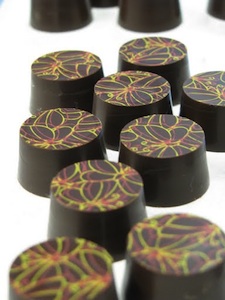 Jeff: That it takes a pretty box to sell chocolates
Jeff: That it takes a pretty box to sell chocolates
Antoine: I believe that there are some chocolates made with ingredients and preservatives that do not belong in fine chocolates
Fritz: I think the biggest misconception is that they often think if they simply put together a chocolate with a ganache with several different flavors and a shell that looks nice and tastes good, they will be making delicious chocolates. However, it is really important to be aware of which shells go well with which ganaches. The marriage of the external and internal flavors of the chocolate is what makes for the best chocolate experience
Martine: That customers don’t taste the difference
12) Do you have a Candide situation---that is, a best-of-all-possible-worlds scenario for your chocolates and your business?
Jeff: I would like to make actual money someday
Antoine: If people learn to view fine chocolates as they should be---as something to be eaten fresh, like other fine foods (for example, fresh breads, pastry, and produce). Fine chocolates should be eaten when they are freshly made; in Europe, they are purchased to be eaten right away, (certainly) within a week or two
Fritz: I would love to have Knipschildt continue to sell to all the best gourmet chocolate shops and stores throughout the (United States) and the world, and to have (branches of my Chocopologie café) open in several more locations around the world
Martine: Being a franchiser
![]()
Stephanie (HandOverTheChocolate@comcast.net) has had a strong affinity for chocolate from a very early age. Family members claim that, as a child, she was able to hear chocolate being opened in the kitchen no matter where she was in the house. Stephanie was baking by the time she was 6 and ran a short-lived baking business out of her parents’ kitchen when she was in high school. She has a Master’s Degree in Foods from Virginia Tech but no formal training in cooking or baking. Consequently, she is a home cook, not a chef. Prior to beginning this column, she had written about chocolate for some 8 years.
Note: This information was accurate when it was published. Please be sure to confirm all rates and details directly with the businesses in question before making your plans.



